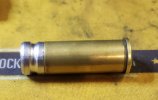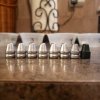I have a question on what is a reasonable expectation of multi cavity mold variances. Been a while since I've posted on here, and had great
help in starting my casting adventures. I shoot more .45 acp 200gr lswc than anything else, so once my supply of commercial cast began
to dwindle, it was time to cast my own. (I got my feet wet with .38's, .44's, and .32's for my revolvers). I powder coat by the way. A fellow shooter gave me a Lee 2 cavity (200 gr) to get started with, and it worked great (until I ran them all through my new Lee push through .452 sizer and they all got sized to .451 .......I've since polished it to .452........).
.......I've since polished it to .452........).
But I quickly realized this 2 cavity was going to be too slow. I bought a used Lee 6 cavity with handles (their H&G version) very inexpensively to try out. I
still ladle pour and wanted to see if that was going to be a problem with a 6 cavity mold, and upgraded to a 20lb pot. Seemed to go okay, able to pour 3 cavities at a time with one scoop of lead. The mold casts great and the bullets fall out easily. They seem to weigh out between 200 to 205 grains with coww.
My question, however, is the bullet length variations per cavity. I'm getting bullet overall lengths from .353 to .367. And the longer ones are
giving me a problem with coal. I'm having to seat the bullet's shoulder nearly flush with the case mouth (like flush or .010 extended) in order to eject a live
round or the nose hangs up at the ejection port. (This is with a Ruger SR1911). The two cavity mold bullets (as well as my commercial cast) are shorter (around .335 and .345). I generally loaded with the shoulder about .025 or so out of the case in the past with any 200gr lswc and they passed the plunk test and ejected fine.
*Is this 6 cavity mold variation considered within expectations? I'm thinking of buying a brand new 6 cavity and not sure whether to try the
Lee again (since it was a used one after all), or maybe an MP mold? (I'm on a budget).
*Is my casting methods giving me the variances?
MP has a traditional lube groove option as well as a nlg style. I prefer the bevel base (I think) and the nlg version is only in plain base.
Any expert opinions to help out a fairly new guy? What is the "normal" length from the Lee 6 cavity?
What is the length of the MP H&G style? What is the length of MP's nlg style?
help in starting my casting adventures. I shoot more .45 acp 200gr lswc than anything else, so once my supply of commercial cast began
to dwindle, it was time to cast my own. (I got my feet wet with .38's, .44's, and .32's for my revolvers). I powder coat by the way. A fellow shooter gave me a Lee 2 cavity (200 gr) to get started with, and it worked great (until I ran them all through my new Lee push through .452 sizer and they all got sized to .451
But I quickly realized this 2 cavity was going to be too slow. I bought a used Lee 6 cavity with handles (their H&G version) very inexpensively to try out. I
still ladle pour and wanted to see if that was going to be a problem with a 6 cavity mold, and upgraded to a 20lb pot. Seemed to go okay, able to pour 3 cavities at a time with one scoop of lead. The mold casts great and the bullets fall out easily. They seem to weigh out between 200 to 205 grains with coww.
My question, however, is the bullet length variations per cavity. I'm getting bullet overall lengths from .353 to .367. And the longer ones are
giving me a problem with coal. I'm having to seat the bullet's shoulder nearly flush with the case mouth (like flush or .010 extended) in order to eject a live
round or the nose hangs up at the ejection port. (This is with a Ruger SR1911). The two cavity mold bullets (as well as my commercial cast) are shorter (around .335 and .345). I generally loaded with the shoulder about .025 or so out of the case in the past with any 200gr lswc and they passed the plunk test and ejected fine.
*Is this 6 cavity mold variation considered within expectations? I'm thinking of buying a brand new 6 cavity and not sure whether to try the
Lee again (since it was a used one after all), or maybe an MP mold? (I'm on a budget).
*Is my casting methods giving me the variances?
MP has a traditional lube groove option as well as a nlg style. I prefer the bevel base (I think) and the nlg version is only in plain base.
Any expert opinions to help out a fairly new guy? What is the "normal" length from the Lee 6 cavity?
What is the length of the MP H&G style? What is the length of MP's nlg style?


